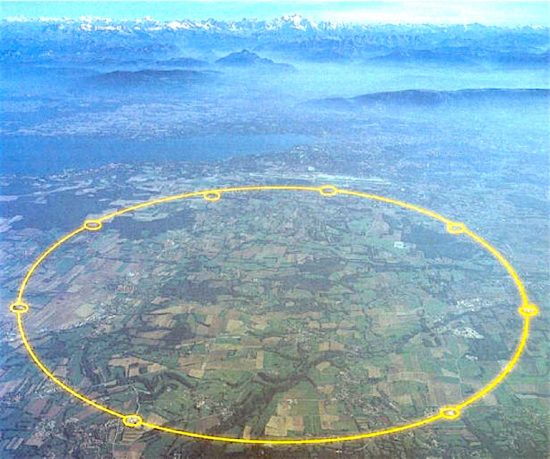
Location of the Large Hadron Collider, CERN, Switzerland.
Nov 22, 2016
The Large Hadron Collider has met with a few unforeseen accidents. Could they be a bizarre case of sabotage?
Originally published October 2009
Particle physicists began thinking about the Large Hadron Collider (LHC) early in the 1980s. The LHC’s predecessor, the Large Electron Positron Collider (LEP) would soon be coming to the end of its useful life, and a higher energy device was needed to investigate the so-called Higgs boson, a yet to be seen component in the theory of quantum mechanics. However, it was in 1994 that the project was finally approved by the 20 nation membership of CERN, inaugurating the start of engineering and design work.
The LHC occupies a 27 kilometer long, circular tunnel, straddling the border between Switzerland and France. Its powerful electromagnets are designed to compress and accelerate a narrow stream of protons, split it into dual, counter-rotating beams, and then collide those beams head on. Full power to the magnets was scheduled for mid-2007, with the first collisions to begin shortly thereafter.
On March 27, 2007, one of the focusing magnets failed when a high-pressure test was conducted. A chain of events resulted in the 20-ton magnet shifting off its foundation, filling the tunnel with helium gas and dust, and causing damage to 24 other magnets. The accident meant waiting an additional two years until November 2009 before they could restart the system. At the time of the accident, Pier Oddone, Fermilab’s director, admitted to being “dumbfounded” that they had missed a “simple balance of forces” in the design, as well as in four engineering reviews. This latest accident, while the most costly by far ($21 million for repairs), is not the first one visited on the LHC.
The alarm systems repeatedly generate false alarms, alarm avalanches, and incorrect alarms. Major project failures have occurred, resulting in the cancelation of physics experiments. Increasingly high computer resources have been required to remove signal noise. The design is so delicate it requires extreme quiet. A 600 kilowatt cryogenic compressor was accidentally destroyed. Fires have broken out.
These and numerous other delays and annoyances have caused two theoretical physicists to write a paper suggesting a reason. No one but one of the paper’s authors, Holger Bech Nielsen, of the Niels Bohr Institute in Copenhagen, can put it more succinctly:
“It must be our prediction that all Higgs producing machines shall have bad luck… Well, one could even almost say that we have a model for God.” It is their guess, said Dr. Nielsen, “that He rather hates Higgs particles, and attempts to avoid them.” In other words, either God or some other force in the future is sending negative influences back through time, so that the discovery of the Higgs boson can never take place.
Nielsen and Masao Ninomiya of the Yukawa Institute for Theoretical Physics in Kyoto, Japan, are authors of several papers discussing this unorthodox theory: “Search for Future Influence From LHC,” for instance.
Influences from the future attempting to prevent something from taking place in the past—our present—to ensure the creation of that future? The discovery of the Higgs boson is, according to Nielsen and Ninomiya, so antithetical to the future’s existence that the future is protecting itself by causing the machines capable of finding the particle to fail or never be built.
As mentioned in a previous Picture of the Day, it is not the intent of the Thunderbolts Project to unduly criticize those who earn their daily bread in the employ of University laboratories or government-backed research institutes. In this case, though, to have Dr. Nielson, one of the originators of string theory, and a respected theoretician, publish a paper that seriously considers time travel and clairvoyant effects from a preexisting future to be a reason for the failure of machines like the LHC smacks of irony.
Stephen Smith












